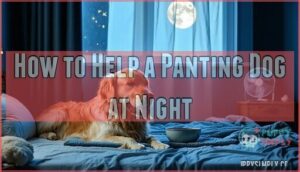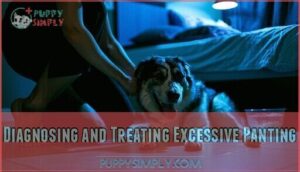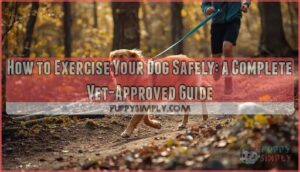This site is supported by our readers. We may earn a commission, at no cost to you, if you purchase through links.
 You know the feeling—night slips in, the house finally settles, but your dog’s panting doesn’t let up. Instead of the quiet you expect, there’s that rhythmic breath, filling your room with a low, restless energy.
You know the feeling—night slips in, the house finally settles, but your dog’s panting doesn’t let up. Instead of the quiet you expect, there’s that rhythmic breath, filling your room with a low, restless energy.
Sometimes it’s heat clinging to the air, sometimes it’s nerves, and sometimes it’s a clue your dog’s hiding something deeper. If you’ve started tracking those nighttime panting spells, wondering if they’re normal or hinting at a real problem, you’re not alone. Understanding why dog panting at night happens can make all the difference for their comfort and your peace of mind.
Table Of Contents
- Key Takeaways
- Why is My Dog Panting at Night?
- Common Causes of Nighttime Panting
- Signs Your Dog’s Panting is Serious
- How to Help a Panting Dog at Night
- When to Seek Veterinary Attention
- Diagnosing and Treating Excessive Panting
- Frequently Asked Questions (FAQs)
- Do dogs pant at night?
- How do I Stop my dog panting at night?
- Why does my senior dog pant at night?
- Why is my dog panting & restless at night?
- Why does my dog Pant when he sleeps?
- Why is my dog panting excessively?
- Why is my dog heavily panting at night?
- When should I worry about dog panting?
- Why is my dog restless and can’t settle?
- Why is my dog overheating at night?
- Conclusion
Key Takeaways
- Nighttime panting in dogs can be triggered by anxiety, pain, heat, or underlying medical conditions like heart disease or Cushing’s.
- Watch for red flags such as abnormal breath sounds, pale or blue gums, lethargy, and changes in appetite or behavior—these signal a need for urgent veterinary care.
- Simple changes like improving room ventilation, keeping fresh water available, and creating a calm sleep environment can ease mild nighttime panting.
- Tracking when and how often your dog pants at night, along with regular checkups, helps spot problems early and supports long-term health.
Why is My Dog Panting at Night?
If your dog pants at night, you’re probably wondering whether it’s normal or something to worry about. Understanding the difference between regular temperature control and signs of trouble can help you know when to act.
Let’s look at what’s behind nighttime panting and which patterns need your attention.
Normal Vs. Abnormal Panting
While all dogs pant to cool down, not every nighttime panting session is just about temperature—sometimes it’s your dog’s way of telling you something’s wrong. Normal dog panting happens after exercise or when it’s warm. Recognizing abnormal dog behavior means watching for these signs:
- Elevated canine respiratory rate without obvious cause
- Abnormal breath sounds like wheezing or labored breathing
- Changes in gum color—pale or bluish tones signal distress
- Exercise intolerance or increased nighttime panting frequency
Symptom tracking helps you spot patterns that warrant veterinary attention.
How Dogs Regulate Temperature
Unlike humans who sweat through their skin, your dog relies almost entirely on panting to shed excess heat and keep their body temperature in check. The evaporation process works through panting mechanics—your dog breathes out hot air and pulls in cooler air over their moist tongue and airways.
Breed differences matter here; flat-faced dogs struggle more with cooling.
Hydration importance can’t be overstated, and environmental temperature directly impacts how hard your dog works to avoid heatstroke.
Nighttime Panting Patterns to Watch
Once you know how panting works, the next step is noticing when your dog’s nighttime breathing doesn’t follow their usual rhythm.
Watch for changes in panting frequency or breathing depth that wake them—or you—repeatedly. Sleep disturbances paired with restlessness or whining are behavioral cues worth tracking.
Pattern changes over several nights, especially without obvious triggers like heat or activity, signal it’s time to dig deeper.
Common Causes of Nighttime Panting
When your dog pants at night without an obvious reason, it can feel worrying. Several factors might be at play, from simple environmental issues to more complex health conditions.
Let’s look at the most common culprits behind nighttime panting.
Stress, Anxiety, and Fear
Just like us, your dog’s mind doesn’t always shut off when the lights go out—and stress, anxiety, or fear can turn a quiet night into hours of restless panting.
Separation anxiety, noise phobias, or fear triggers from the day can keep your dog on edge. Changes in routine or unfamiliar sounds make nighttime dog behavior worse.
Calming techniques like behavioral therapy, a safe den space, or pheromone diffusers can help ease dog anxiety and stress.
Pain and Discomfort
When pain strikes—whether from arthritis flaring up, dental trouble, or an injury you can’t see—your dog may pant through the night just trying to cope.
Arthritis pain worsens when joints stiffen during rest. Dental issues, chronic pain conditions, and post-surgery discomfort can all trigger physical discomfort that keeps your dog awake and panting.
Watch for restlessness, limping, or reluctance to move.
Heat and Environmental Factors
If your home feels like a sauna after a long summer day, your dog’s nighttime panting might be their way of saying the bedroom’s too warm. Poor ventilation and high ambient temperature make cooling difficult. Breed sensitivity varies—thick-coated breeds struggle more with climate impact.
Without proper hydration strategies, environmental temperature issues can quickly lead to dehydration or even heatstroke. Environmental issues like stuffy rooms demand immediate attention.
Medical Conditions (Heart Disease, Cushing’s, Respiratory Issues)
Sometimes medical conditions hijack your dog’s ability to breathe easy at night. Heart disease affects up to 75% of senior dogs and often triggers panting when fluid builds in the lungs. Cushing’s disease—a hormonal imbalance—causes persistent panting in about half of affected dogs, often alongside increased thirst. Respiratory problems like pneumonia or chronic lung disease make nighttime breathing a struggle. Certain breeds face higher breed predisposition to these issues, making diagnostic monitoring essential for catching problems early. As dogs lack sweat glands, panting regulates temperature, but excessive nighttime panting can be a red flag.
- Heart failure can leave your dog gasping for air, unable to lie down comfortably
- Cushing’s impact shows up as relentless panting, even in cool, calm environments
- Respiratory distress forces dogs to sit upright through the night, wide-legged and exhausted
- Medical conditions often simmer for months before diagnosis—don’t ignore the warning signs
Aging and Cognitive Dysfunction
Your dog’s aging brain can blur the line between night and day, leaving them restless and panting when they should be sound asleep. Canine Cognitive Disorder—often called dog dementia—affects roughly 28% of dogs aged 11-12 and jumps to 68% by age 15. Sundowning syndrome causes confusion at dusk, triggering anxiety and sleep disruption that can last all night.
| Dementia Signs | What You’ll See | Senior Care Response |
|---|---|---|
| Confusion and pacing | Wandering aimlessly, staring at walls | Establish consistent routines, night lights |
| Reversed sleep cycles | Active at night, sleeping all day | Mental enrichment during daytime hours |
| Increased anxiety | Whining, panting, seeking constant comfort | Calming supplements, veterinary consultation |
Cognitive decline doesn’t mean your senior dog is beyond help—early intervention and proper senior care can slow progression and improve quality of life.
Signs Your Dog’s Panting is Serious
Most panting at night is harmless, but some signs mean you need to act fast. If your dog shows any of the warning signs below, don’t wait to see if things improve on their own.
Here’s what to watch for.
Abnormal Breath Sounds and Difficulty Breathing
Breathing that sounds harsh, raspy, or labored is often your dog’s way of telling you something isn’t right. Watch for these warning signs of respiratory distress:
- Wheezing and panting together, which suggests airway narrowing
- Noisy breathing like honking or whistling during rest
- Labored breathing with obvious chest or belly effort
- Abnormal breathing patterns—rapid, shallow, or irregular
Respiratory problems won’t wait. If you notice these breathing issues alongside nighttime panting, your dog needs veterinary evaluation soon.
Pale or Blue Gums
A quick check of your dog’s gums can reveal whether their nighttime panting is a minor inconvenience or a medical emergency. Healthy gums are pink and moist. Pale or blue gums signal that blood oxygen levels have dropped, which is a veterinary emergency requiring immediate response.
Check gums by gently lifting your dog’s lip. If you see gum color changes alongside panting, don’t wait—get emergency care. These dog symptoms mean your pet isn’t getting enough oxygen.
| Gum Color | What It Means | Possible Causes |
|---|---|---|
| Pale or white | Anemia signs, poor circulation | Blood loss, anemia, shock |
| Blue or purple | Cyanosis causes, oxygen deprivation | Breathing problems, heart disease |
| Bright red | Overheating or toxin exposure | Heatstroke, medical conditions |
| Yellow | Liver issues | Jaundice, organ dysfunction |
Lethargy, Vomiting, and Drooling
Beyond gum color, watch for other warning signs like lethargy, vomiting, or excessive drooling—these symptoms can point to serious underlying problems when they show up alongside nighttime panting.
Lethargy causes include infections, pain, or organ dysfunction. Different vomiting types signal various medical conditions, from stomach upset to toxin exposure. Drooling severity increases with nausea or respiratory distress.
These dog symptoms together raise dehydration risks and show symptom overlap that demands veterinary care quickly.
Changes in Appetite or Behavior
Pay attention to shifts in your dog’s eating habits or overall demeanor, as these behavioral changes often reveal underlying health problems when paired with nighttime panting.
Dog behavior changes that warrant concern include:
- Appetite shifts: refusing food, eating less, or showing loss of interest in meals
- Sleep changes and increased vocalization: restlessness, whining, or sudden aggression during nighttime hours
- Withdrawal patterns: hiding behavior or avoiding interaction when normally social
These signs combined with dog panting suggest your dog needs veterinary evaluation to identify what’s causing the discomfort.
How to Help a Panting Dog at Night
If your dog is panting at night, there are practical steps you can take to help them feel more comfortable. Some solutions address the immediate environment, while others focus on emotional well-being.
Here’s what you can do to ease your dog’s nighttime panting.
Cooling and Ventilation Tips
When the air inside starts to feel stuffy, a few simple tweaks around the house can help your four-legged friend stay comfortable through the night. Proper ventilation strategies and cooling surfaces can prevent environmental temperature spikes that trigger excessive panting.
By following these tips, you’ll help keep your pet cool and comfortable, while lowering their risk of overheating.
| Cooling Method | How It Helps |
|---|---|
| Open windows/fans | Improves air circulation |
| Cooling mats | Provides cool surface contact |
| Fresh water bowls | Prevents dehydration |
| Shade provision | Blocks heat sources |
| AC or ventilation | Controls temperature |
Reducing Stress and Anxiety
While keeping things cool is a good start, you’ll also want to help your pup settle their nerves as night falls. Dog panting at night is often tied to stress or anxiety, so try these calming techniques:
- Create safe spaces for bedtime
- Use pheromone therapy diffusers
- Consider anxiety medication with your vet
- Try positive training methods
- Practice gentle behavior modification
Providing Water and Comfort
Sometimes, in the quiet hours before sunrise, a bowl of fresh water and a cozy spot to rest can be just what your best friend needs to breathe easy. Make sure the water bowl is easy to reach, bedding is comfortable, and the room stays cool.
Nightlights and safe spaces help with nighttime panting, supporting both dog health and wellness.
Using Calming Aids and Supplements
If you’ve ever wished you could bottle up a little peace and quiet for your pup at bedtime, calming aids and gentle supplements might be the next best thing. Herbal remedies, CBD oil, and pheromone therapy can help ease stress or pain, but always follow dosage guidelines.
Sticking with these supplements and combining them with positive behavior training can really help them work better—just keep an eye out for how your pup responds over time.
When to Seek Veterinary Attention
Sometimes, a dog’s nighttime panting means a bit more than just being too warm or restless. It helps to know what signs shouldn’t be ignored.
Here are the moments when calling your vet makes all the difference.
Emergency Symptoms to Watch For
You know your dog best—so trust your instincts when things feel off. Some red flags mean it’s time for an emergency veterinarian, including:
- Labored breathing or unusually heavy breathing
- Gum discoloration (pale, blue, gray, or bright red)
- Sudden behavioral changes like confusion or collapse
- Vomiting, drooling, or signs of severe GI distress tied to cardiac events
Recognizing abnormal dog behavior quickly can save a life. If your dog is also panting excessively, it could be a sign of underlying conditions.
Monitoring and Tracking Panting Patterns
Think of tracking your dog’s nighttime panting like putting together pieces of a puzzle—it helps you spot changes before they turn into bigger problems. Noting panting frequency and duration, along with environmental factors or recent activity, reveals meaningful pattern analysis.
Dog health monitoring apps now let you log sleep quality and dog nighttime behavior, providing clear activity patterns for your vet.
Importance of Regular Checkups
Just like you wouldn’t skip your own doctor’s visits, your dog needs regular checkups to catch small health issues before they become big headaches. That’s where early detection shines, helping spot breed predispositions or subtle changes in nighttime panting.
Regular veterinary care means:
- Health baselines for your dog
- Preventative care and cost savings
- Peace of mind for your family
Diagnosing and Treating Excessive Panting
When your dog’s panting at night becomes frequent or intense, it’s time to look closer at what’s going on.
There are several steps vets use to sort out the cause and find the right fix. Here’s what you can expect if you’re facing this issue at home.
Veterinary Exams and Diagnostic Tests
Wondering why your dog pants all night? A thorough physical exam is the first step your veterinarian takes. From there, diagnostic imaging looks inside for hidden issues, while blood tests analyze organ function. Checking heart function and monitoring at home can complete the puzzle. Here’s how it all comes together:
| Step | What It Reveals |
|---|---|
| Physical exam | Breathing, gums, pain, posture |
| Diagnostic imaging | Chest, abdomen, hidden problems |
| Blood tests | Infection, organ, hormone issues |
| Heart function/case monitoring | Cardiac, breathing status |
Treatment Options for Underlying Conditions
Once your vet figures out what’s causing your dog’s nighttime panting, the next step is finding the right treatment to help your dog breathe easier and rest well.
Treatment options for dogs depend on the cause—sometimes medication helps anxiety or heart disease, while pain might need palliative care. Surgical interventions or lifestyle adjustments can also play a role, along with alternative therapies as needed.
At-Home Monitoring Tools and Technology
After sorting out treatment with your veterinarian, it’s reassuring to know there are simple tools these days that help you keep an eye on your dog’s breathing and comfort at home.
Wearable sensors and smart beds track activity patterns, while remote thermometers and panting apps offer early detection.
Even simple video monitoring can help you spot changes in your dog’s wellbeing quickly.
Frequently Asked Questions (FAQs)
Do dogs pant at night?
Nighttime panting in dogs is both ordinary and a little mysterious—sometimes a sign of healthy cooling, other times a red flag.
Normal panting signs often relate to warmth, while abnormal panting hints at pain, discomfort, or underlying respiratory problems.
How do I Stop my dog panting at night?
Start with cooling strategies like a fan, and make sure fresh water’s always nearby.
Try anxiety reduction tools or calming products, and use comforting routines.
Don’t hesitate to schedule a veterinary consultation if nighttime panting or sleep quality worsens.
Why does my senior dog pant at night?
Older dogs may pant at night from pain, stress, medication side effects, or even cognitive dysfunction like senior dog dementia.
Sleep disorders and nighttime restlessness can appear as arthritis pain relief needs or changes in their sleep environment.
Why is my dog panting & restless at night?
Your dog’s panting and nighttime restlessness can signal anxiety, pain, medical conditions, or sleep disorders. Behavioral changes, Cognitive Decline, or even environmental adjustments may cause sleep disruption. Noticing persistent symptoms deserves your attention.
Why does my dog Pant when he sleeps?
When your dog pants during sleep, it can be the tip of the iceberg—signals like breed predisposition, sleep panting triggers, anxiety, pain, or underlying medical conditions, including sleep apnea.
Watch Panting Intensity and consider their Sleep Environment at night.
Why is my dog panting excessively?
If your dog is panting much more than usual, it could be a sign of health problems, changes in their environment, or stress.
Watch for exercise intolerance or behavioral changes—these signs often hint at anxiety, medical conditions in dogs, or shifting dog health issues.
Why is my dog heavily panting at night?
Watching your dog pant at night can feel as unsettling as hearing thunder on a clear evening. Nighttime panting triggers range from anxiety and pain to medical conditions in dogs, so identifying root causes and considering environmental adjustments is key.
When should I worry about dog panting?
Worry when panting severity jumps, gums turn pale or blue, breathing becomes tough, or behavior shifts—such as exercise intolerance or sudden lethargy.
Recognizing abnormal dog behavior and dog health concerns early makes a vet consultation essential.
Why is my dog restless and can’t settle?
Restlessness in your dog can stem from anxiety triggers, pain, a poor sleep environment, cognitive decline, or lack of exercise. Breed predisposition also plays a role.
Watch for changes in behavior and health that signal deeper concerns.
Why is my dog overheating at night?
Too much heat or poor environmental control at night can leave your dog struggling to regulate body temperature.
Improper bedding choices, low hydration levels, or certain breed predispositions make heatstroke and repeated overheating a real risk.
Conclusion
Imagine if you’d to explain your odd bedtime habits to a room full of strangers—your dog’s nightly panting might feel just as awkward. Dog panting at night isn’t some mysterious canine comedy sketch, even if it seems out of place.
It’s a signal, a puzzle piece in understanding your dog’s well-being. Pay attention, trust your instincts, and don’t let silence fool you. In your dog’s world, even a restless breath can speak volumes.
- https://wsava.org/wp-content/uploads/2020/01/Recognition-Assessment-and-Treatment-of-Pain-Guidelines.pdf
- https://www.rivergateveterinaryclinic.com/site/blog/2024/06/14/dog-panting-night
- https://www.gentledranimalhospital.com/site/blog/2024/02/15/dog-panting-night
- https://petkeen.com/danger-of-heat-stroke-in-dogs/
- https://blog.mywaggle.com/everything-you-must-know-about-dog-panting/















